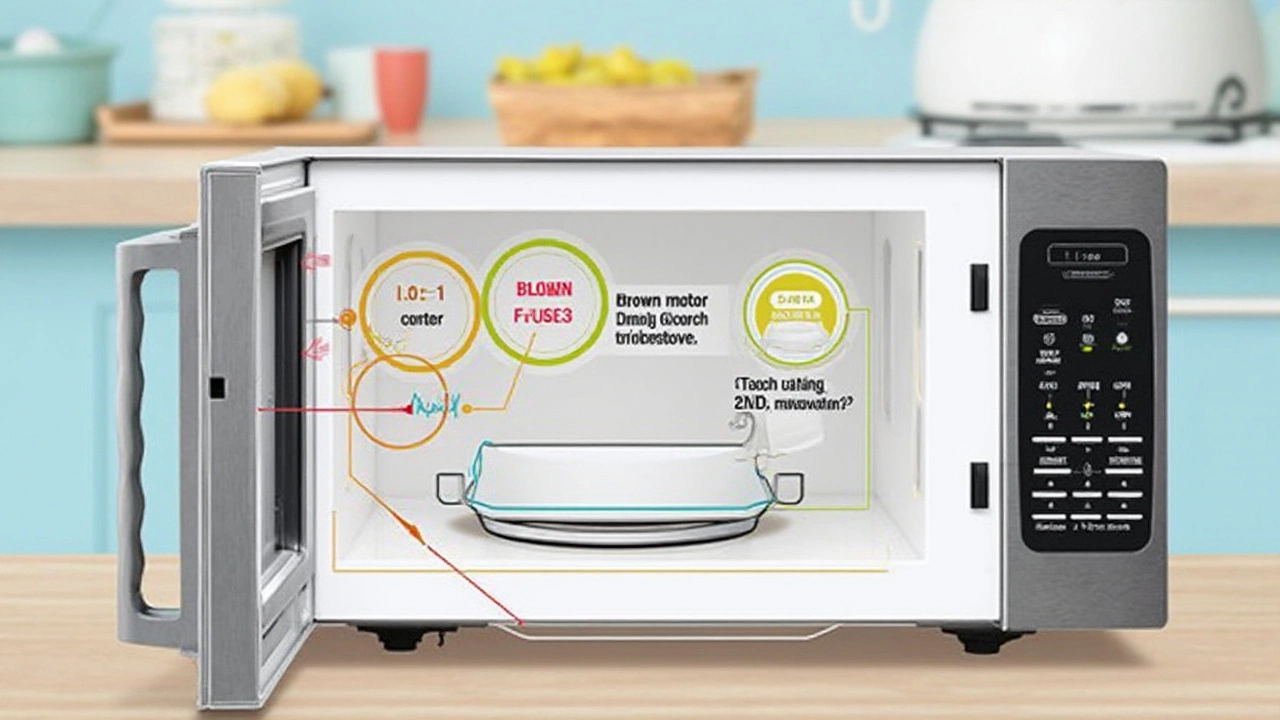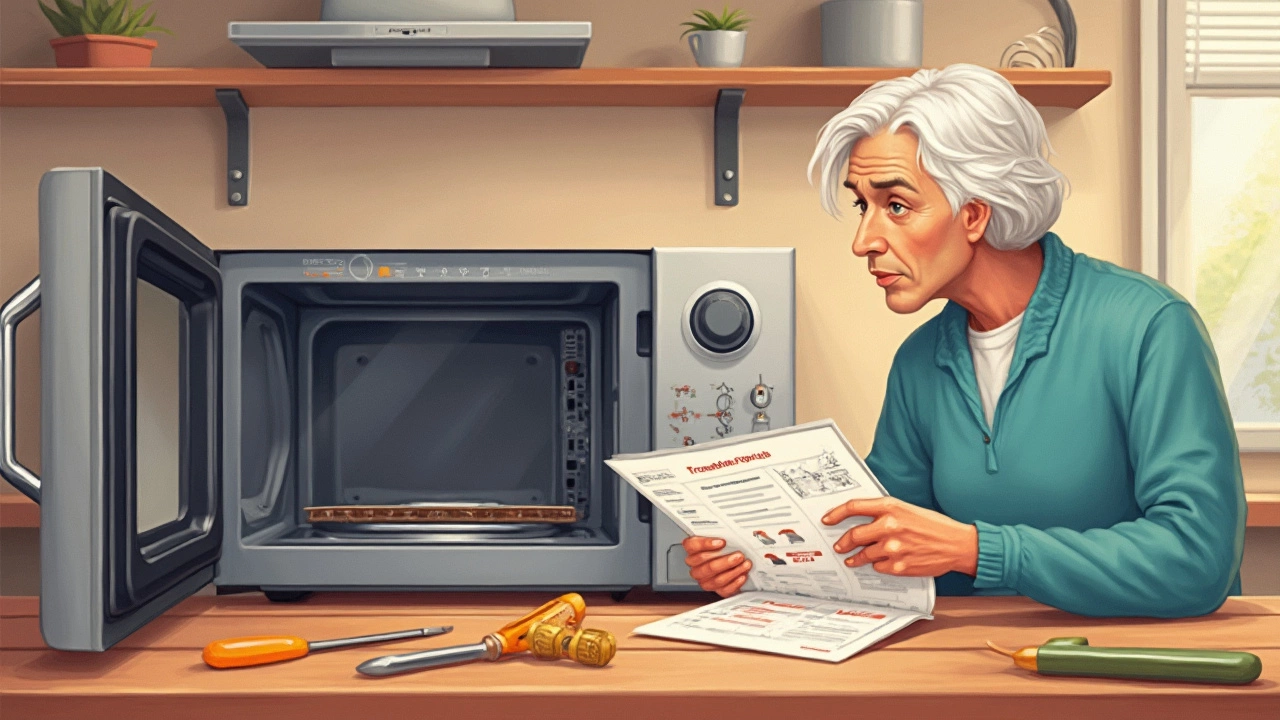Ever had a microwave just quit in the middle of reheating leftovers? You're definitely not alone. Most people assume it's something simple, like a blown fuse or a loose plug, but the number one reason these kitchen workhorses die? It's usually the magnetron—the part that actually makes the microwaves that heat your food.
What’s wild is that a magnetron tends to fail just as the microwave hits a certain age or if it's used for long stretches at a time (looking at you, midnight popcorn marathons). If you've noticed your microwave sounding weird, sparking, or not heating at all even though it turns on, the magnetron is probably toast.
Thing is, magnetron issues aren’t something you fix with duct tape. But knowing this can save you hours trying to troubleshoot random buttons or fuses. We’ll dig into what happens inside your microwave, the telltale signs of trouble, and some smart steps you can actually take—no engineering degree required.
- Microwave Anatomy: What’s Inside That Counts
- King of Failures: The Magnetron Problem
- How to Spot Warning Signs
- DIY Fixes and When to Call a Pro
Microwave Anatomy: What’s Inside That Counts
Pop the cover off a microwave (not saying you should!) and you’ll find a few key parts working together to zap your cold pizza back to life. Knowing what these parts are—and what they do—gives you the upper hand when something goes wrong.
First up, the transformer is like the muscle of the team. It boosts your regular wall power to the crazy high voltage the magnetron needs to function. Without it, your microwave would be basically a light show with no heat.
Then there’s the magnetron itself. This is the “engine” that creates the microwaves. It uses the high voltage to shoot out waves, which bounce around the inside and heat up your food. When folks talk about their microwave breaking down, it’s almost always pointing back to this guy.
Another big player is the high-voltage capacitor. It works with the transformer to keep the power flow steady. Think of it as a battery that charges fast and then dumps energy when needed. If this part fails, you’ll hear buzzing… but your food stays stone cold.
Don’t forget the door switch. It’s not just a safety feature—it literally stops the show if the door isn’t fully closed. If your microwave turns on but then stops for no reason, this tiny switch might be the issue.
You’ll also find smaller parts like the control board (the brains), the turntable motor (for the plate that spins), and sometimes a fuse for basic protection. While fuses can blow, it’s usually because something else—like the magnetron or capacitor—went bad first.
- Transformer: amps up the voltage.
- Magnetron: creates the microwaves.
- High-voltage capacitor: keeps the juice flowing steady.
- Door switch: makes sure the door is closed tight.
- Control board: handles your commands and settings.
- Turntable motor: keeps your food rotating for even heating.
Before blaming any single part, a quick look at how these pieces interact helps zero in on problems. Most of the time, microwave failure isn’t about something simple—there’s usually a fried magnetron or another heavy-hitter inside calling it quits.
King of Failures: The Magnetron Problem
The magnetron sits at the heart of every microwave, and when it fails, your microwave basically turns into a fancy bread box. This part sends out those microwaves that actually cook or heat your food. No working magnetron? No hot food. Simple as that.
Why do these things kick the bucket so often? For starters, the magnetron is under a ton of stress every time you hit “Start.” It uses super high voltage and gets incredibly hot. Over time, that wears out even the toughest components. Surges in electricity from your power line or running the microwave with nothing inside (which you should absolutely avoid) can kill the magnetron even faster.
Here’s how it usually goes down:
- Your microwave starts making a loud buzzing or humming noise that wasn’t there before.
- It stops heating food, even though the light and turntable are still working.
- Sometimes you’ll even smell burning or see sparks. Not a good sign.
One authentic fact: According to service data from major appliance repair shops, the magnetron is responsible for over half of non-heating complaints they see with microwaves. Companies like Samsung and Whirlpool have even listed magnetron failure as the top reason for microwave returns under warranty. That’s how common it is.
Don’t waste time swapping fuses or clicking buttons if your microwave turns on but doesn’t heat—odds are high it’s the magnetron. Only an experienced DIYer with the right tools should open a microwave, though, since the high voltage can be dangerous even when unplugged. If you suspect the magnetron is dead, it usually makes more sense to call a pro or, depending on the cost, consider getting a new microwave. For most folks, replacing the magnetron yourself isn’t worth the risk or hassle.

How to Spot Warning Signs
Catching microwave trouble early can save you a lot of hassle. The best move is to pay attention to how your microwave acts—don't ignore little changes, because they often show up before a full-blown breakdown.
The microwave repair pros point out that weird noises, sparks, or a sudden loss of power aren't just random flukes. They're your microwave's way of begging for help. According to Consumer Reports, "If your microwave isn't heating—even if the light and turntable still work—chances are the magnetron's gone bad."
Look for these obvious signs:
- No heat: Food comes out cold, even after a full cycle. That's usually the magnetron failing.
- Strange noises: Buzzing, humming, or clicking are pretty much red flags. Normal microwaves hum, but things like clanking or squealing are not normal.
- Sparks or burning smell: Sparks inside, or a weird burnt smell, means you need to shut it down ASAP. Never ignore sparks.
- Display problems: Flickering lights or a blank screen can mean a power supply problem, but if it still runs cold, it's often deeper than that.
- Longer cooking times: If popcorn used to take 2 minutes but now takes 4, your microwave’s output is probably dropping fast.
Here's a quick cheat sheet of what certain signs might mean:
| Warning Sign | Possible Cause | Recommended Action |
|---|---|---|
| No heat | Failed magnetron | Consider replacement or repair |
| Sparks inside | Damaged waveguide cover or food residue | Unplug and clean, call for service if persists |
| Weird noises | Worn-out turntable motor or magnetron | Professional inspection needed |
| Burnt smell | Overheated magnetron or electrical component | Stop using and call a technician |
| Longer cook times | Magnetron weakening | Likely replacement needed |
Bottom line: your microwave doesn't fail overnight. Little things spell trouble long before it stops working completely. The trick is to notice these before you're stuck with cold leftovers and a big repair bill.
DIY Fixes and When to Call a Pro
Alright, so your microwave isn’t working. Before you rush out to buy a new one or call an expensive repair service, try a few safe, practical tricks. But let’s get real: some microwave repairs aren’t worth risking your safety or your wallet.
Start with the basics. Unplug the microwave for a minute, then plug it back in. Simple, but you’d be surprised how often this little power cycle sorts out weird glitches. If nothing changes, check your kitchen circuit breaker or outlet with another appliance—microwaves pull a ton of power, so a tripped breaker isn’t unusual. Still not working? Move on to these approachable steps:
- Microwave repair rarely starts with yanking out the big parts. Instead, check the door switch. If the microwave light stays on even when the door is shut, or if it won’t start at all, a busted door switch is a usual suspect. Replacing one is pretty easy and cheap (usually under $20—just unplug and unscrew, pop in a new switch, and you’re set).
- Blown fuses are another culprit. Look up your model’s fuse location, unplug the microwave, remove the cover (if you’re comfortable), and check for a blown ceramic fuse. Replacements cost less than a fancy coffee.
If none of these fix the problem and you’re dealing with a dead magnetron, here’s the hard truth: replacing a magnetron is pricey and risky. Magnetrons can cost $50–$120, and the repair takes serious electrical know-how. Plus, microwaves store enough voltage in their capacitor to shock you well after unplugging. Not worth the ER visit for most of us.
| Repair Type | DIY Cost | Professional Cost |
|---|---|---|
| Door Switch | $10–$20 | $60–$120 |
| Fuse | $8–$15 | $60–$100 |
| Magnetron | $50–$120 | $120–$350 |
So, when do you call a pro? If your microwave is arcing, smoking, making loud humming sounds, or just not heating at all (even if everything else checks out), don’t mess with it. Also, microwaves over seven years old often aren’t worth a pricey fix—sometimes, a replacement is smarter.
The bottom line: keep DIY repairs to simple stuff like fuses and door switches. Anything more complicated, especially stuff inside the microwave’s guts, should be left for someone with the right tools and safety gear. One phone call could save your dinner—and maybe your fingers too.


